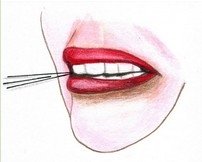Speech Therapy Z Sound

Speech Therapy Z Sound: The /z/ sound is a stream of air (fricative) sound and is a sound partner to the /s/. The /z/ is voiced and the vocal folds vibrate. To produce a clear /z/ sound the tongue is raised high in the mouth to almost touch the alveolar ridge, the roof of the mouth.
This action by the tongue creates a groove in the centre of the tongue through which the air-stream flows. The positioning and action of the tongue constricts the space through which the breath stream travels pro-ducing friction.
/z/ Sound Errors
The /z/ sound production is a common speech sound error. Many children at some stage in their speech and language development have difficulty producing the /z/ sound.
The most common sound error is for the /z/ to be misarticulated as the voiced /th/ sound, or to use the correct IPA symbol, the /ð/ sound.
Click on image to download /z/ sound information page.
Speech Therapy Z Sound - Sound Stimulation
Explain correct /z/ production to your child.
- To make the /z/ sound, the top of the tongue nearly touches the roof of the mouth (alveolar ridge), the little bumpy bit behind the top teeth.
- The lateral (side) edges of the tongue lightly touch the upper back teeth.
- The vocal folds vibrate which can be felt if you place a finger on your larynx during /z/ production.
- The air-stream passes through the centre of the mouth over the shallow valley formed between the tongue and the roof of the mouth.
- The lips are slightly opened and the teeth are close together but not touching.
/z/ Sound Stimulation
Explain and model the following /z/ sound production techniques for your child.
- Raise your tongue so that you can feel the upper teeth at the back of the mouth.
- Touch the tongue tip at the roof of the mouth then lower it so that it doesn’t touch any structure in the mouth. The tongue tip should feel like it is just below the roof of the mouth (alveolar ridge).
- Open your lips a little to allow the air-stream to pass over the top of your tongue and through the lips.
- Allow the air-stream to flow over the middle of the tongue. (Try not to use the term, blow. The term blow can be confusing to children who at-tempt to blow the airstream which tends to change the structure of the mouth)
- Don’t allow your tongue to protrude between the teeth. Allow the teeth to slightly touch if necessary to begin with. Try to keep the tongue be-hind your front teeth at all times. (This is particularly relevant for chil-dren with interdental /z/ production)
Speech Therapy Z Sound - Sculpting from other Speech Sounds
Many speech sounds can be sculpted using other speech sounds as a starting point. This involves altering or adjusting speech sounds so that they approach the target sound in nature. This works by the clinician modeling a sound that the child is able to produce. The clinician then makes slight, progressive adjustments to the sound until the target sound is generated.
Speech Therapy Z Sound - Sound Sculpting from the /d/ Sound
Sculpt the /z/ sound from the /d/ sound.
- First, model the /d/ sound for the child. The /d/ sound is made by touch-ing the tongue tip to the roof of the mouth just behind the top teeth (the alveolar ridge). The mouth shape for the /z/ sound is in almost the exact same position as the /d/ after the tongue drops after completion of the /d/ sound, which makes production of the /z/ sound very easy to sculpt from the /d/.
- Next, instruct the child to repeat the /d/ sound a number of times ddddddd. Model this sequence to the child.
- Finally, after producing multiple repeats of /d/ ddddd, instruct the child to extend the final /d/ into a sustained zzzzz, the /z/ sound.
Speech Therapy Z Sound - Sound Sculpting from the /n/ Sound
Sculpt the /z/ sound from the /n/ sound.
- First, model the /n/ sound for the child. As with the /d/ sound, the /n/ sound is made by touching the tongue tip to the roof of the mouth just behind the top teeth (the alveolar ridge). The/n/ sound is a voiced nasal and can be used to help sculpt the voiced fricative /z/.
- Next, sustain the /n/ sound for a few seconds. Note that the tongue is placed on the alveolar ridge and then released.
- Instruct the child to release the tongue and produce a sustained /z/ sound. This is relatively easy to model and then produce. Once the /n/ sound completes, the voiced nasal will automatically transition to th
Updated 27/07/2020

